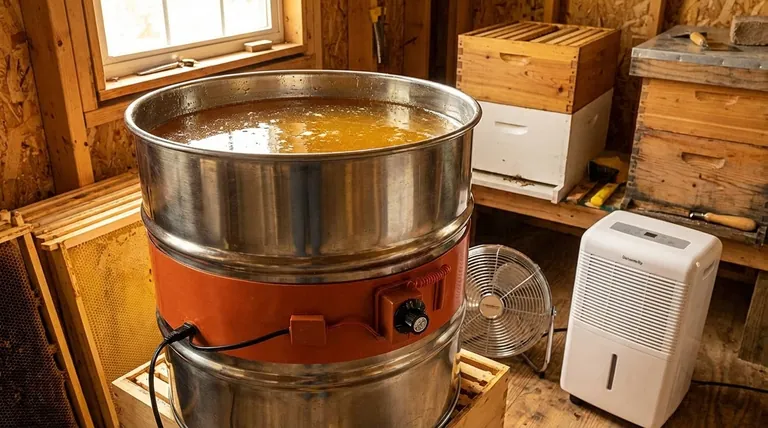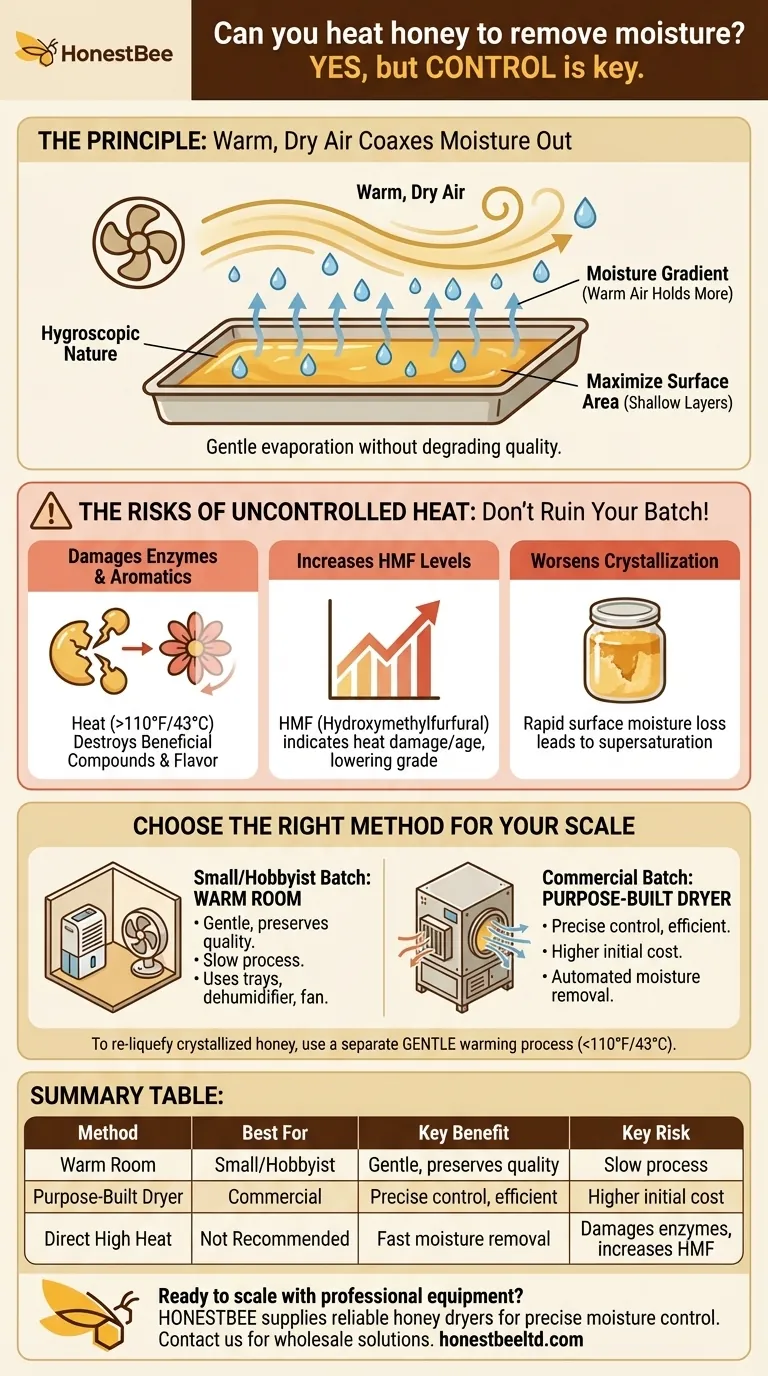Yes, you can use heat to remove moisture from honey. However, the method is critical, as simply heating honey in an open container is an uncontrolled process that can damage its quality and may even encourage crystallization later on. The goal is to use gentle, warm air to create an environment that coaxes moisture out without degrading the honey itself.
The most effective way to reduce moisture in honey isn't through direct, high heat, but by using a combination of controlled warmth and circulating dry air. This process gently evaporates water without destroying the delicate enzymes and aromatic compounds that define high-quality honey.

The Principle: How Warm Air Dries Honey
Honey is hygroscopic, meaning it can both absorb moisture from and release moisture into the surrounding air. The process of drying honey is about tipping this balance in your favor.
Creating a Moisture Gradient
The core principle is to create a large difference in moisture levels between the honey and the air. Warm air can hold significantly more moisture than cold air.
By warming the air and keeping its relative humidity low (using a dehumidifier), you create an environment where the water molecules in the honey are actively drawn out into the hungry, dry air.
The Importance of Surface Area
Evaporation only happens at the surface. To speed up the process, you need to maximize the honey's exposure to the dry, moving air.
This is why commercial honey dryers often let honey flow in thin layers over a series of baffles. For smaller batches, this means keeping it in shallow trays.
The Critical Risks of Using Uncontrolled Heat
Applying heat incorrectly is the fastest way to ruin a batch of honey. Direct, high heat is a significant threat to its quality.
Damaging Enzymes and Aromatics
Honey contains beneficial enzymes, such as diastase and invertase, which are sensitive to heat. Overheating (generally above 110°F or 43°C) can permanently destroy them.
Similarly, the delicate floral notes and aromas in honey are volatile compounds that are easily "cooked off," leaving behind a generic, overly sweet flavor.
Increasing HMF Levels
Hydroxymethylfurfural (HMF) is a compound formed when sugars are heated. While not harmful in small amounts, its presence is a key indicator of heat damage or old age in honey.
Many quality standards set strict limits on HMF levels. Applying excessive heat will cause these levels to spike, effectively degrading the honey's grade and value.
Worsening Crystallization
While it seems counterintuitive, heating honey uncovered can lead to rapid moisture loss from the surface. This can create a supersaturated sugar solution that is even more prone to crystallization once it cools.
Making the Right Choice for Your Goal
Your approach should depend on your batch size and desired quality.
- If your primary focus is a small, hobbyist batch: Use the "warm room" method. Place the honey in shallow, food-safe trays in a small, clean room with a dehumidifier and a fan to circulate the air.
- If your primary focus is consistent, commercial-grade quality: Invest in a purpose-built honey dryer. These systems are designed to control temperature and airflow precisely for efficient and safe moisture removal.
- If your honey is already crystallized: Gently warming the honey (e.g., in a water bath below 110°F / 43°C) will re-liquefy it, but this is a separate process from targeted moisture removal.
Controlling honey's moisture content is the key to ensuring its long-term stability and preserving its unique character.
Summary Table:
| Method | Best For | Key Benefit | Key Risk |
|---|---|---|---|
| Warm Room with Dehumidifier | Small/Hobbyist Batches | Gentle, preserves quality | Slow process |
| Purpose-Built Honey Dryer | Commercial Batches | Precise control, efficient | Higher initial cost |
| Direct High Heat | Not Recommended | Fast moisture removal | Damages enzymes, increases HMF |
Ready to scale your honey processing with professional-grade equipment? HONESTBEE supplies commercial apiaries and distributors with reliable honey dryers and beekeeping supplies designed for precise moisture control. Protect your honey's quality and maximize shelf life—contact our experts today to discuss wholesale solutions tailored to your operation.
Visual Guide

Related Products
- Silicone Rubber Honey Drum Heating Belt
- Easy Use Manual Stainless Steel Honey Press for Honey Comb
- Electric 8 Frame Honey Spinner Extractor Equipment for Beekeeping
- 0.5T Capacity Honey Dehumidifier Dryer with Vacuum Heating and Thickening Filtering Machine
- Stainless Steel Manual 8 Frame Radial Honey Extractor Machine for Beehives
People Also Ask
- Does heating honey pasteurize it? Understanding the Trade-Offs for Your Beekeeping Business
- What is the recommended temperature for heating honey in a press? Preserve Quality & Maximize Yield
- How do you heat honey for bottling? Preserve Quality with Gentle Warming Techniques
- Do you have to heat honey before bottling? A Guide to Quality vs. Efficiency
- What safety and maintenance tips should be followed when using a honey bucket heater? Ensure Honey Quality and Equipment Longevity



















